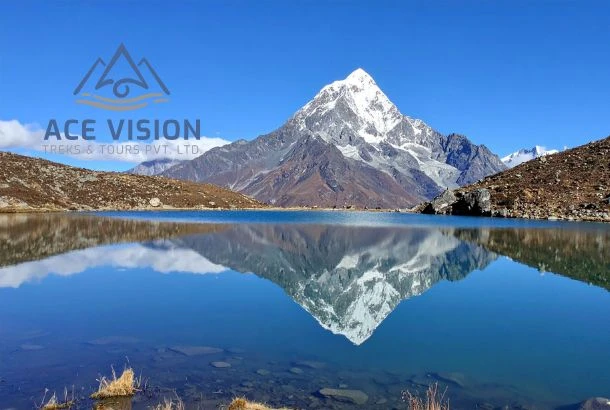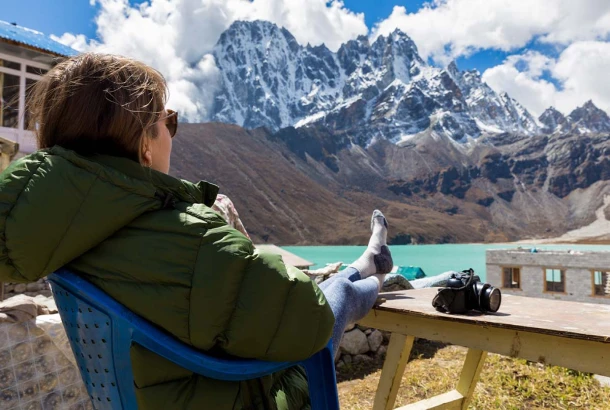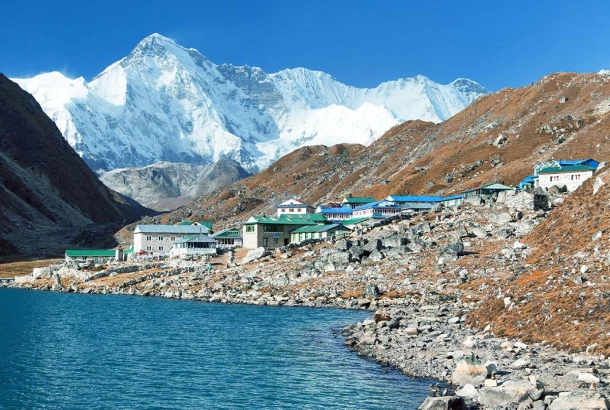Seasonal Insight for Kanchenjunga Trek
| Season | Notable Points |
| Spring (March to May) | ● One of the ideal times for the Kanchenjunga Base Camp Trek. ● Stable climate and mild weather ● Vibrant rhododendrons along the trail |
| Autumn (September to November) | ● The weather is stable, with clear, sharp views of the stunning peaks. ● Moderate and pleasant daytime temperatures for trekking. ● Prime time for the Kanchenjunga Base Camp Trek. |
| Summer/ Monsoon (June to August) | ● Lush Scenery and tranquil trails. ● Heavy rainfall, muddy trails, and humid weather at lower elevations. |
| Winter (December to February) | ● Exceptional mountain views and winter landscapes. ● Cold weather, snowy trails that require advanced navigation skills and the right gear. |
Best Time for Kanchenjunga Base Camp Trek

Spring (March to May)
The spring season is one of the ideal times for the Kanchenjunga Base Camp Trek. This pre-monsoon period has clear weather, dry trails and long daylight hours that are suitable for high altitude treks. As winter's cold fades away, you can see the magical scenery of the Kanchenjunga Region during this period. The forests, hills and valleys are covered with colorful rhododendrons.
As winter snows gradually melt, the spring season brings warmth to the surroundings and provides relief from freezing temperatures. The climate is sunny, and daytime weather is mild so you can trek at ease without worrying about heat or freezing cold. The trails of Kanchenjunga are dry, which makes it much safer, as well as more enjoyable, to trek. The skies are clear in the spring months. So, you can see clear views of Kanchenjunga and the surrounding peaks.
One of the notable points of spring trekking is longer daylight hours. This allows you to trek at your own comfortable pace. You will have ample time each day to enjoy the scenery, rest and without having to rush to your next stop. Due to perfect trekking conditions, spring is a popular season for the Kanchenjunga Trek.
In brief, spring offers an ideal mix of stunning natural landscapes, good weather and ideal trekking trails. Thus, it stands out among the finest seasons to experience the magic of the Kanchenjunga Base Camp Trek.
Autumn (September to November)
Autumn is another peak season for the Kanchenjunga Base Camp Trek. At this time, you can expect to encounter other trekkers on the trail. It is the preferred season for most trekkers because of the clear and stable climate, well defined trails and ideal trekking conditions. These perfect conditions provide an exhilarating Himalayan experience.
As the monsoon rains start to subside, the skies clear up, providing exceptional clarity of the surroundings. The autumn air is dry and cool, and the landscapes that are nourished by the monsoon rains are lush and vibrant.
At the beginning of September, there is a likelihood of light rainfall. So, carrying rain gear is a must during this season. By mid-September, the weather typically stabilizes, and you can enjoy trekking on dry trails, clear weather conditions with alluring mountain views. With very little likelihood of heavy rains or snow showers, the trails are firm and easy to walk on. Thus, trekking becomes more comfortable and enjoyable.
Daytime temperatures are mild, which is considered ideal trekking weather. The sunny days, combined with the refreshing Himalayan wind, make the exploration of the trails. delightful. However, the nights in the higher zones can be cold during this season, typically, so warm layered clothing and good sleeping bags are necessary. By November, nights at higher than average altitudes are chill, and there can be some snow up in the higher areas. So, you must check the trail conditions before heading out.
Autumn is also the season of festivals in Nepal. The natives of Kanchenjunga celebrate festivals like Dashain and Tihar. Thus, you can witness local mountain culture and rituals and even celebrate the festival together with locals. Therefore, the combination of cool climate, stable weather conditions, and enhanced visibility makes autumn the most desirable time for high-altitude trekking.
Trekking in Off-Season
Winter (December to February)
During winter months, the Kanchenjunga region is serene and turns into a snowy paradise. The less busy trails and serenity of the snow-covered environment during this season allow for a deep connection to nature. In addition, the winter skies are clear, and the mountains and high altitude passes are covered with layers of fresh snow.
It is crucial to research the challenges of this time. Temperatures drop significantly at upper zones , dipping well below freezing. The heavy snowfall can make high-altitude passes often become impassable in the winter months because of heavy snow buildup. The teahouses and lodges in higher areas may close down during winter. So, making inquiries about the availability of accommodation is essential. In addition, crampons and ice axes might be required for a smooth trek in the snowy sections.
The winter landscape is stunning. Trekkers need to be prepared with insulated, good-quality clothing and gear to handle extreme cold. Thus, Kanchenjunga Base Camp Trek in winter is best suited for very experienced trekkers who can handle cold and unpredictable weather conditions.
Summer/ Monsoon (June to August)
The monsoon season is widely regarded as the least suitable times for trekking in the Kanchenjunga region. The persistent heavy rainfall transforms terrains into muddy paths. This can increase risk of slips and falls that may cause injuries.
The likelihood of landslides and flooding is high at this time, which can frequently obstruct routes and require itinerary adjustments. Additionally, the leeches and mosquitoes in the forested lower trails make the journey uncomfortable and require insect repellents.
In this season heavy clouds can obstruct the Himalayan peaks. In addition, continuous downpours may lead to swollen rivers which can often wash out bridges. Some sections of trail can be impassable this season.
The lush rain nourished scenery can be vibrant. However, the poor visibility and muddy trail conditions make navigation challenging. Thus, careful preparation and resilience are required to tackle the trek difficulty and face the unpredictable conditions of this season.
Monthly Temperature of Kanchenjunga Base Camp Trek
| Month | Temperature on Day Time | Nighttime Temperatures |
January | 5 °C to -10°C | -10 °C to -20°C |
| February | 4 °C to 0°C | -8 °C to -15 °C |
| March | 8°C to 10°C | 0 °C to -10 °C |
| April | 4 °C to 12 °C | 0 °C to -8 °C |
| May | 10°C to 16 °C | 5 °C to -6 °C |
| June | 12 °C to 20°C | 0 °C to 8 °C |
| July | 15 °C to 20°C | 2 °C to 12°C |
| August | 12 °C to 22°C | 2 °C to 10°C |
| September | 12 °C to 15 °C | 4°Cto -2°C |
| October | 5°C to 16°C | 0 to -5°C |
| November | 8 °C to -2°C | 5°C to 10 °C |
December | 4 °C to -5°C | 10 °C to -15°C |
Packing List for Each Season

Spring and Autumn
Spring and Autumn are the best times for the Kanchenjunga Base Camp Trek. The weather is stable with moderate temperatures during these high trekking periods. The weather is sunny and warm during the day times and mornings and evenings at higher elevations are cold. So, for these periods, you need to have layered clothes that you can adjust according to the temperatures. You can include the following items for trekking in spring and autumn:
- Moisture-wicking Thermals
- Rain Gears
- Down Vests
- Flexible Hiking pants
- Sun hats
- Scarf
- Beanie
- Warm Socks
- Fleece Jackets
- Warm Down Jackets
- Hiking Boots
- Sandals
Summer/ Monsoon
Monsoon months feature frequent heavy rains and high humidity. Trekking at this time can be more difficult with slippery trails and poor visibility because of cloud cover. Though this is not a popular time for trekking, the Kanchenjunga Trails are lush and serene. However, proper packing and preparation are required for a smooth trek during this season. You may add the following items to your bag for Summer/ Monsoon trekking
- Rain Jackets and Pants
- Leg Gaiters
- Waterproof Trekking Boots
- Moisture-wicking base layers
- Lightweight and quick-drying trekking shirts and pants
- Liner socks
- Warm Gloves
- Trekking Sandals
- Insect repellent
- Quick drying undergaments
- Leech socks
- Sun hats
- Rain Poncho
- Backpack with rain cover
- Dry bags
Winter
Winter is coldest in the Kanchenjunga Region, This season brings heavy snowfall and freezing temperatures. The experienced trekkers who are capable of handling snow take part in this scenic adventure this season. You will require warm clothes and high-quality trekking equipment to remain secure and comfortable in the freezing weather of these months. Here are some clothing and footwear essentials for winter trekking:
- Beanie
- Thermal base layers
- Warm sweaters
- Fleece Jackets
- Down Jackets
- Woolen socks
- Insulated gloves
- Waterproof Down Jackets
- Trekking Tshirts
- Waterproof Hiking Boots
- Rain Jackets
- Thick scarves
- Comfortable and moisture-wicking undergarments
- Crampons
- Ice axes
Essential Items to Pack for Every Season
Certain items should always make it into your pack during the Kanchenjunga Trek for every season. These essentials provide safety, comfort and allow you to maintain hygiene. Carrying these essentials is necessary to feel confident and stay well prepared during the high altitude trek.
Trekking Gears
- Trekking poles
- A daypack
- Headlamps
- Sleeping Bags
- Flashlights
Other Essentials
- First aid kit ( Pain relievers, Bandages and other essential medications)
- Hand sanitizer
- Sunscreen
- Toothbrush and Toothpaste
- Quick-drying towel
- Wet Wipes
- Insect repellent
- Comb
- Trekking Maps
- Power bank
- Emergency whistle
- Oral Rehydration Salts
- Refillable Water Bottle
- High Energy Snacks
- Trekking Permits
- Water Purification Tablets
- Waste Disposal Bags
- Smartphone
- Cash
Factors to Consider to Choose the Right Time for the Kanchenjunga Trek

Determining the best time for the Kanchenjunga Base Camp trek requires thoughtful planning. The following are some of the key things you should consider before embarking on your adventure.
Trail Conditions
It is most important to know about the seasonal trail conditions for a smooth Kanchenjunga trek. Spring and Autumn are generally the best seasons to trek with dry and well defined trails that are safer and comfortable for walking. These seasons offer the most ideal trail conditions, especially for those wishing for a comfortable navigation.
During the monsoon/summer season, heavy rain makes trails muddy and slippery making the trek exhausting. Thus, this season is mainly suitable for experienced trekkers with good navigation skills. In winter, the higher sections of the trails may be slippery and covered in snow. The experienced trekkers can take part in this scenic trek this month, as handling winter cold and traversing snowy paths can be difficult for beginners.
Understanding what the trail is like in every season allows you to select the time most suitable for your comfort and expectations. Thus, make sure to research the trails and select them according to your interests and experience.
Crowd Preferences
The crowd level on the trail can affect your experience quite significantly. Though the Kanchenjunga Trek is generally tranquil it has managed to gradually capture the adventurer's attention.
During the most popular periods of the year (autumn and spring), the trails tend to be more lively with a number of trekkers. This can be a great means of socialization. You can share travel stories and learn about each other's experiences. Likewise, during off seasons (winter and summer/monsoon), the trails are more serene. So, this can be a good time for those who prefer to trek in a peaceful atmosphere with fewer people around.
You can select the season based on the crowd preferences. If you prefer an interactive journey, you can choose to trek in peak seasons. On the contrary, if you are an experienced trekker looking for a serene journey, then you may choose the off-season for Kanchenjunga Trekking.
Physical Fitness and Experience

You can consider your physical fitness and trekking experience to determine the right time. For novice high altitude trekkers, it is highly recommended to trek in less demanding seasons (Spring and Autumn). At these times trails are relatively easier to navigate. These seasons offer stable weather, beautiful views and excellent trail conditions. Choosing these seasons provides a more enjoyable experience.
Trekking in off seasons like winter or monsoon presents relatively more challenges than peak seasons. The monsoon season has muddy and slippery terrains. On the other hand, winter season's snowy and icy trails require you to put more effort when navigation. The conditions during winter and summer/ monsoon time require stamina, high-quality gear, and good navigation skills.
You need to evaluate your physical health and experience level before choosing a trekking season to prepare yourself for various conditions. Choosing the best season, depending on your physical fitness and experience, helps you ensure a safer and a joyful trek, increasing the chances of successfully completing the journey.
Scenery
The scenery you prefer to see is one of the important factors that you need to consider before choosing the time for trekking. Each season is special and offers diverse scenery. Autumn presents clear skies and stunning mountain scenery. During this time of year, sunrises and sunsets are stunning. The landscapes of Kanchenjunga are lush and appear surreal.
The spring season offers exceptional scenery of the landscapes. The wildflowers are in full bloom this season, especially rhododendrons, adding color to the landscape. The blooming flora looks ethereal with the hills and mountains in the background.
In the summer/monsoon season, you can see lush green landscapes with mountains covered in mist. In the winter season you can behold stunning views of the mountains. The landscapes of the Kanchenjunga region are covered with fresh layers of snow, rewarding you with the scenery of the winter wonderland. However, the cold, short daylight hours, and adverse weather conditions require adequate preparation.
The winter landscapes are ethereal, and if you are well-experienced in navigating the snowy paths, then you can have a great time. You can select the season based on the scenery you have envisioned seeing during the trek and fully enjoy your trekking experience.
Final Say: When to Embark on the Kanchenjunga Trek?
Trekking at the right time allows you to witness the breathtaking scenery and form a strong bond with the natural environment. The timing can truly make a difference to your experience. Understanding the specialities and challenges of each season will help you to plan when to travel and enjoy a good trekking experience.
Trekking during winter or summer/monsoon presents a unique charm of the region ,like serene trails, distinct views, and fewer travelers. These seasons can be more challenging because of the weather. Trekking during off seasons requires planning, necessary gear, and physical conditioning and flexibility in the schedule.
Spring and Autumn are the most ideal months to venture out, because of their favorable climate and unmatched scenery. The months are also top picks for several trekkers. Teahouses can fill quickly in these seasons, so you should book early to get quality accommodations. For the best trekking experience, it is highly recommended to trek during spring and autumn.
Also Read: Best Time to Visit Mustang









